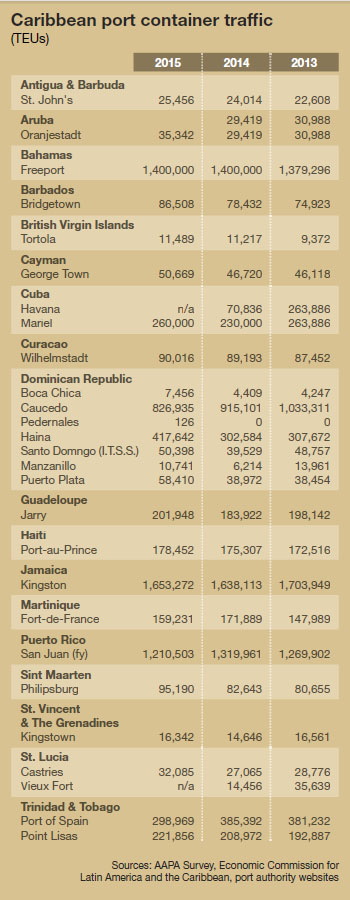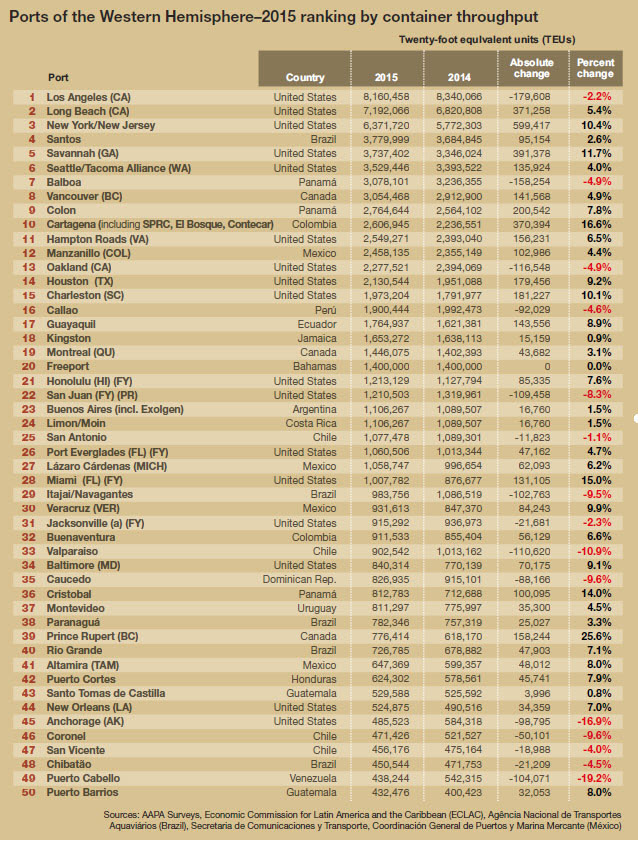Regional ports concentrate on growth and connectivity
With the Panama Canal expansion complete, ocean cargo gateways in the Caribbean are investing to position themselves as logistics hubs to attract an ever-growing number of carriers serving this dynamic marketplace.
Latest Logistics News
U.S.-bound import growth track remains promising, notes Port Tracker report Q&A: Port of Oakland Maritime Director Bryan Brandes Signs of progress are being made towards moving cargo in and out of Baltimore New Breakthrough ‘State of Transportation’ report cites various challenges for shippers and carriers in 2024 Industry experts examine the impact of Baltimore bridge collapse on supply chains More PortsEven when it was first proposed, the concept of digging a canal in the troubled nation of Nicaragua was not considered a safe bet by most shipping analysts. Now that Panama’s expansion project has been completed, that prospect is much more of a long shot.
Meanwhile, the possible lifting of the U.S. trade embargo with another communist nation in the region— Cuba—has created some speculation that it may one day become a viable logistics hub in the Caribbean.
If there’s a common thread running through the developing story of the Caribbean Basin, it’s Chinese investment. Hong Kong-based Hutchison Port Holdings, which operates the Panama Canal, also runs Freeport Container Port on Grand Bahama, a northern island on the Bahamas. It’s also actively courting officials at Cuba’s deep-water port of Mariel.
And then there’s Jamaica, which aspires to join Rotterdam, Dubai and Singapore as the fourth node in the international logistics chain. According to George Anthony Hylton, Jamaica’s minister of industry, investment and commerce, the island nation compares favorably with the existing three nodes, as it’s positioned astride the trade routes in the Windward Passage and has access to the 800 million person market of North, Central and South America.
“We sit at the doorway of the expanded Panama Canal,” observes Hylton, “and our government got to work addressing the issues of both the physical infrastructure and the other components necessary to reach this goal two years ago.”
Jamaica’s “Global Logistics Hub Initiative” launched last October, is the cornerstone of the country’s future economic development. According to industry analysts watching the region, it will involve multiple modalities through the integration of seaports throughout the Basin. This will include the handling of containers, dry bulk and liquid bulk commodities and the development of airports, special economic zones, free zones, logistics centers and trade facilitation mechanisms.
Florida’s ports poised
While concentrating on welcoming the new generation of “mega” vessels that can’t transit the Panama Canal, U.S. ports on the eastern and southeastern seaboard have been also actively wooing calls from smaller “post-Panamax” ships serving the region. This is particularly true of ocean cargo gateways in Florida.

“Florida ports have had a long relationship of trade with the Caribbean nations, and are proud to count them as some of our most valuable partners,” says Doug Wheeler, president and CEO of the Florida Ports Council.
Representatives from all aspects of the maritime shipping industry met in Cocoa Beach, Fla., in May for the Caribbean Shipping Associations’ (CSA) Shipping Executives Conference, an event that focused on the emerging market opportunities in the Basin. However, as dark legends about the “Bermuda Triangle” illustrate, the Basin in home to scores of sudden and violent eruptions of nature every year—a topic that can never escape a CSA event.
“Caribbean nations all share a common maritime connection and have a shared interest in safe and secure commerce,” observes CSA’s general manager Fernando Rivera, who adds that “resilience” is another shared objective.
“We have a shared concern to respond promptly and appropriately when natural disasters or man-made crises occur,” says Rivera. “Earthquakes, hurricanes, tsunamis, volcanoes, wildfires, pandemics, terrorist activity and cyber-attacks can have a devastating impact, especially on smaller nations in the Caribbean region.”
Florida’s shippers also recognize the Basin’s vulnerability to disasters related to climate change. “Industry leaders must to be prepared to help their companies and their families to mitigate risk with proper preparations and safeguards,” says Rick Murrell, president and CEO of the Miami-based transportation company Tropical Shipping.
Eduardo Pagan, Tote Maritime’s vice president and general manager for the Caribbean, agrees, noting that U.S. companies are uniting to ensure a more stable shipping environment in the region. “It’s a team effort,” he adds. “And despite all of it’s challenges, hemispheric collaboration is finally taking hold.”
Carrier investment
Puerto Rico looms large for ocean carriers calling Florida’s ports, too. Crowley Puerto Rico Services recently announced that it is continuing to invest there with the execution of an additional $21 million construction contract for improvements and upgrades at its Isla Grande port terminal in San Juan.
According to spokesmen, it’s the latest in a series of investments in support of the trade that will make Crowley’s terminal and shipping operations the most modern and efficient in all of Puerto Rico. Emerging market analysts note, however, that the troubled island continues to have serious solvency problems.
The Crowley construction contract was awarded to Del Valle Group, S.P. of Toa Baja, Puerto Rico, and includes expanding the terminal’s capacity for handling refrigerated containers; paving 15 acres to accommodate container stacking; installing a new electrical substation to provide power for three new ship-to-shore gantry cranes; constructing a new seven-lane terminal exit gate; and installing hardware required for a new, state-of-the-art terminal operating software system
The contract is the third awarded that is associated with Crowley’s investment in its Isla Grande terminal in preparation for the arrival next year of the first of Crowley’s two new LNG-powered Commitment Class ships now under construction in Pascagoula, Miss.
“This contract represents the last major contract to be awarded in our $500 million investment in our Puerto Rico Jones Act service,” says John Hourihan, Crowley’s senior vice president and general manager for Puerto Rico. “With construction of both Commitment Class ships underway, dredging at Isla Grande completed, and pile driving operations associated with the pier ongoing, we are beginning to see the results of our investment taking shape.”
Alec Lee, an analyst with Washington DC-based Frontier Strategy Group, an emerging markets consultancy, is less bullish on investment prospects there.
He notes that just weeks after passing a debt moratorium law, the government of Puerto Rico defaulted to the island’s Government Development Bank. In doing so, it has essentially chosen to prioritize current spending on key social services, rather than service its interest and amortization payments that fell due last May.
“The decision follows months of negotiations in the U.S. House of Representatives where lawmakers had attempted to cobble together a deal that would facilitate the restructuring of Puerto Rico’s nearly $70 billion in debt, while also providing a federal oversight board to insure the island puts its fiscal house in order,” observes Lee.

Mixed forecast
Other Caribbean Basin ports may have financing challenges as well, say World Bank analysts who contend that, for the fifth consecutive year, the Latin American & Caribbean region (LAC) faces a continuing decline in growth for exporters
As a result, LAC didn’t grow in 2015 and is expected to contract by 1% in 2016. According to the World Bank, the region’s growth average is weighed by the slowdown in important economies such as Venezuela and Brazil.
“Policy makers worry that the constricted prospects may jeopardize the social gains of the past decade, pushing Latin American economies into the so-called middle income trap,” says World Bank trade analyst Oscar Calvo-Gonzalez.
According to the World Bank reports, Caribbean countries are struggling to find a balance between reducing spending and minimizing its effects on economic activity and hard-won social gains. “Over the last decade, the region experienced a deep economic and social transformation, which lifted millions out of poverty and swelled the ranks of the middle class,” says Calvo-Gonzalez.
Strong economic growth—driven by both domestic reforms and a favorable global economic environment—was responsible for this progress. Complementary social programs, made possible by growing fiscal space, helped support the poor and disadvantaged.
However, the region’s deceleration is beginning to dent such expansion, according to recent findings. Kurt Nagle, president and CEO of the American Association of Port Authorities, believes that the Panama Canal expansion may be the catalyst for more positive change.
“With the opening of the new set of locks that can accommodate much larger vessels, the canal will provide new trading opportunities for U.S. ports as well,” Nagle notes. “This may be a transformational event for the entire Basin.”

Article Topics
Ports News & Resources
U.S.-bound import growth track remains promising, notes Port Tracker report Q&A: Port of Oakland Maritime Director Bryan Brandes Signs of progress are being made towards moving cargo in and out of Baltimore New Breakthrough ‘State of Transportation’ report cites various challenges for shippers and carriers in 2024 Industry experts examine the impact of Baltimore bridge collapse on supply chains Port of Baltimore closed indefinitely to ships after 1.6-mile Key Bridge collapses following maritime accident February and year-to-date U.S. import growth is solid, reports S&P Global Market Intelligence More PortsLatest in Logistics
GXO’s acquisition of Wincanton is a done deal Q1 sees a solid finish with strong U.S.-bound import growth, reports S&P Global Market Intelligence Understanding the FTC’s ban on noncompetes UPS rolls out fuel surcharge increases U.S. rail carload and intermodal volumes, for week of April 20, are mixed, reports AAR Baltimore suing ship that crashed into bridge, closing port, costing jobs Intermodal growth volume remains intact in March, reports IANA More LogisticsAbout the Author
Subscribe to Logistics Management Magazine

Find out what the world's most innovative companies are doing to improve productivity in their plants and distribution centers.
Start your FREE subscription today.
April 2023 Logistics Management

Latest Resources














